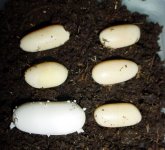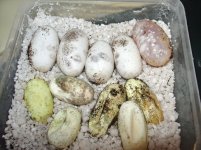okay well I got an unexpected clutch of eggs*my male turned out to be a female and was sold to us gravid we think* now the eggs are on spaghnum moss with a covering of it on top also being kept at about 30C in an incubator,i ve been told by a pal they are fertile he checked them with a torch! and they were healthy very white oblong shaped eggs all laid separately around the viv but they seem to be collasping instead of staying white parts of them have gone see through almost and seem to shrinking inward,and my question is,is this due to to much humidity or not enough?is it better to let them dry out or do I keep adding water to them its in a little cup inside the incubator so they aren't sat in the water but the moss is damp!!!or do I need to soak the eggs or let them dry out? I don't know what to do with them and none of the books seem to go that much into detail about how the eggs should be looking while in incubation,so any advice or ideas please!! if I can save these I'd really like too
-
Hello!
Either you have not registered on this site yet, or you are registered but have not logged in. In either case, you will not be able to use the full functionality of this site until you have registered, and then logged in after your registration has been approved.
Registration is FREE, so please register so you can participate instead of remaining a lurker....
Please be certain that the location field is correctly filled out when you register. All registrations that appear to be bogus will be rejected. Which means that if your location field does NOT match the actual location of your registration IP address, then your registration will be rejected.
Sorry about the strictness of this requirement, but it is necessary to block spammers and scammers at the door as much as possible.
You are using an out of date browser. It may not display this or other websites correctly.
You should upgrade or use an alternative browser.
You should upgrade or use an alternative browser.
egg question?first time unexpected breeder
- Thread starter Shimmer
- Start date
CornCrazy
What's one more???
They should be plump and fairly firm throughout the incubation process. Mine typically get a little softer near hatching time, but they still stay good and round. Can you post pics? If not, then my best guess is that it is not humid enough OR they aren't really fertile. I have had "fertile-looking" eggs turn out to be infertile. How long has it been since they were candled?
gardenmum
Hopelessly Addicted
I agree with Terri, either they are not damp enough or they are not fertile, as you had thought.
When they were candled, did you or that person see red veins throughout the egg? I have had "questionable" eggs that I was unsure if they were fertile or slugs and put them in the incubator with the obvious fertile ones and they ended up not be fertile. If you are unfimiliar with the different looks of fertile vs unfertile, it can be easy to mistake whether they are or not.
Here is a couple pictures of fertile and unfertile eggs. The first picture is one good viable egg with 5 slugs on the day they were laid. The second picture shows two sets of eggs, the first set I knew was viable, the second (bottom) ones looked like they were viable as they didn't look like the obvious slugs in the first picture but were nice and white. Even though they looked viable and seemed to be plumping up at first, within three weeks they started looking moldy and started to "cave in." I cut the eggs open and the insides were firm, jelly like, no liquid and no signs that any baby had been forming.
When they were candled, did you or that person see red veins throughout the egg? I have had "questionable" eggs that I was unsure if they were fertile or slugs and put them in the incubator with the obvious fertile ones and they ended up not be fertile. If you are unfimiliar with the different looks of fertile vs unfertile, it can be easy to mistake whether they are or not.
Here is a couple pictures of fertile and unfertile eggs. The first picture is one good viable egg with 5 slugs on the day they were laid. The second picture shows two sets of eggs, the first set I knew was viable, the second (bottom) ones looked like they were viable as they didn't look like the obvious slugs in the first picture but were nice and white. Even though they looked viable and seemed to be plumping up at first, within three weeks they started looking moldy and started to "cave in." I cut the eggs open and the insides were firm, jelly like, no liquid and no signs that any baby had been forming.
Attachments
gardenmum
Hopelessly Addicted
BTW....to keep the eggs from drying out, the best thing to do is to put the eggs with the moss in a covered container with no holes in it in your incubator. Moisture evaporates quickly in uncovered dishes. I put mine in perlite, only part of the egg into the medium, and cover the container and put in the incubator. I check them weekly but have only had to add moisture to one container throughout the incubation time.
The thing to remember.....for anyone who is reading this thread.....is that your medium needs to stay moist throughout the incubation time but NOT soggy. I put perlite half way up or so into a plastic container like the Glade sandwiche ones, or a larger one if more eggs than will fit in the sandwiche size, and then fill the container with warm water. I let it soak for a half a minute than simply pour out all the water that will freely pour out. Then I put the eggs partially into the medium, cover the dish and put it into the incubator. Other than the obvious bad eggs that I toss or questionable eggs that I try out, I have had almost 100% hatching success of viable eggs with this so far. I say almost because I did loose one baby just prior to hatching last year and have no explaination as to why.
Good luck with those eggs, by the way. I hope they are viable and hatch for you. That was a great added bonus to get a lady with eggs instead of a boy.
The thing to remember.....for anyone who is reading this thread.....is that your medium needs to stay moist throughout the incubation time but NOT soggy. I put perlite half way up or so into a plastic container like the Glade sandwiche ones, or a larger one if more eggs than will fit in the sandwiche size, and then fill the container with warm water. I let it soak for a half a minute than simply pour out all the water that will freely pour out. Then I put the eggs partially into the medium, cover the dish and put it into the incubator. Other than the obvious bad eggs that I toss or questionable eggs that I try out, I have had almost 100% hatching success of viable eggs with this so far. I say almost because I did loose one baby just prior to hatching last year and have no explaination as to why.
Good luck with those eggs, by the way. I hope they are viable and hatch for you. That was a great added bonus to get a lady with eggs instead of a boy.
they are definately fertile theres red veins and like a red umbical spot in a few of the ones that have gone slighty transparant,oddly enough a few seem fine but some look like the yellow ones in the second picture they seem to be shrinking inwards,there was one slug in the batch and my pal cut that open and said even seemed like it should have been viable as it had veins and yolk etc in it,before they went in the incubator they were in a tupperware box on a heat mat and seemed to be doing fine  they were white and slighty soft to the touch but firm now they seem to be squishy in places and see through almost,now I'm not so sure but I guess I ll keep trying with them anyway,thank you for all the good advice anyway
they were white and slighty soft to the touch but firm now they seem to be squishy in places and see through almost,now I'm not so sure but I guess I ll keep trying with them anyway,thank you for all the good advice anyway
Serpwidgets
New member
If they're denting/caving, it's either because they're dead or not humid enough. They will still show veins when candled if they were initially viable but died later, either from their own defects, or a bad environment.
How warm were they in the tupperware box? I've seen such a setup go over 50 C...
At this point I would definitely recommend vermiculite, or anything that can keep more moisture and have more surface contact than moss. (Never used perlite so I can't say if it's good or bad for that.) IMO, if they're drying out, anything beats moss.
How warm were they in the tupperware box? I've seen such a setup go over 50 C...
At this point I would definitely recommend vermiculite, or anything that can keep more moisture and have more surface contact than moss. (Never used perlite so I can't say if it's good or bad for that.) IMO, if they're drying out, anything beats moss.
I've also had some (mostly from the same female) "gel" during incubation, some died off, some hatched. But all of the hatchlings that came from eggs that had any gel in them were kinked and/or otherwise deformed. Some died "fully formed" in the egg, never pipped.Even though they looked viable and seemed to be plumping up at first, within three weeks they started looking moldy and started to "cave in." I cut the eggs open and the insides were firm, jelly like, no liquid and no signs that any baby had been forming.


